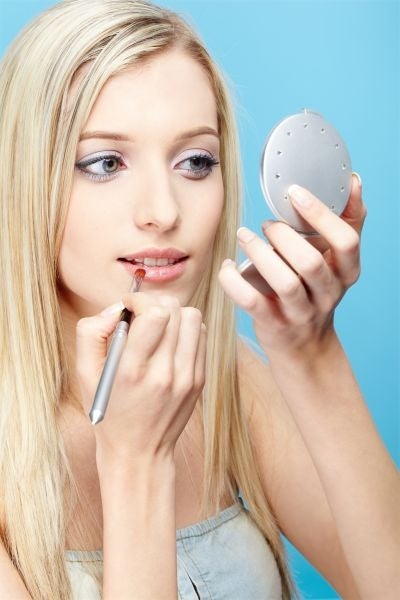Your support helps us to tell the story
From reproductive rights to climate change to Big Tech, The Independent is on the ground when the story is developing. Whether it's investigating the financials of Elon Musk's pro-Trump PAC or producing our latest documentary, 'The A Word', which shines a light on the American women fighting for reproductive rights, we know how important it is to parse out the facts from the messaging.
At such a critical moment in US history, we need reporters on the ground. Your donation allows us to keep sending journalists to speak to both sides of the story.
The Independent is trusted by Americans across the entire political spectrum. And unlike many other quality news outlets, we choose not to lock Americans out of our reporting and analysis with paywalls. We believe quality journalism should be available to everyone, paid for by those who can afford it.
Your support makes all the difference.No one wants a lipstick laden with toxic chemicals. Wondering what to look for on the label? Here is a list of 12 of the worst offenders, according to Canadian researchers.
Last week, Canada's The David Suzuki Foundation, a charitable Canadian group dedicated to environmental conservation and education, published its own list of the worst offenders in personal care products.
In the spring of 2010, the foundation invited 6,200 Canadians to participate in an online survey about toxic ingredients in cosmetics. Participants were asked to check ingredient lists for 12 sets of chemicals (listed below), linked to health and environmental concerns, including cancer, reproductive disorders, asthma and severe allergies. Around 12,500 personal care products were included in the survey.
Findings showed that 80 percent of products reportedly contained at least one of the 12 chemicals, and more than half of the products reported contained multiple ingredients from the worst-offender list. In addition, participants were unable to locate ingredient lists on more than 1,000 products.
12 Worst Offenders in Personal Care Products:
1. BHA and BHT - Used in moisturizers and makeup, these preservatives may cause cancer and are harmful to fish and other wildlife.
2. Coal tar dyes ( p-phenylenediamine and colors listed as "Cl" followed by 5 digits) - Used in hair dyes and cosmetics, these dyes are potential carcinogens and can be contaminated with heavy metals.
3. DEA, cocamide DEA and lauramide DEA - Used in creamy and foaming products, like moisturizers and shampoos, DEAs have been linked to cancer.
4. Dibutyl phthalate - Used as a plasticizer in some nail care products, this is a suspected endocrine disruptor and reprodutive toxin.
5. Formaldehyde-releasing preservatives ( DMDM hydantoin, diazolidinyl urea, methenamine, quarternium-15 and sodium hydroxymethylglycinate) - Found in cosmetics, these are said to slowly release cancer-causing formaldehyde in small amounts.
6. Paraben, methylparaben, butylparaben and propylparaben - Used as preservatives, parabens are reported to interfere with male reproductive functions.
7. Fragrance or Parfum - Artificial fragrances used in all kinds of cosmetics can trigger allergic reactions, asthma, and some are linked to cancer.
8. PEGs - Used as a cream base for some cosmetics, these can be contaminated with 1,4-dioxane, which is linked to cancer.
9. Petrolatum - Used in hair products, lip balms, moisturizers, and lipsticks, this petroleum product can be contaminated with polycyclic aromatic hydrocarbons, which may cause cancer.
10. Siloxanes ( cyclotetrasiloxane, cyclopentasiloxane, cyclohexasiloxane and cyclomethicone) - Used to soften, smooth and moisten, these appear in a variety of cosmetics and are suspected endocrine disruptors and reproductive toxins.
11. Sodium laureth sulfate - Used in foaming cosmetics like shampoos, cleansers, and even toothpaste, this can be contaminated with 1,4-dioxane, which is linked to cancer.
12. Triclosan - The controversial antibacterial agent may contribute to antibiotic resistance in bacterial strains.
The foundation states that loopholes in Canada's cosmetic ingredient labelling requirements result in incomplete ingredient lists on many products. Notably, manufacturers are not required to disclose specific fragrance ingredients on the product label. "Instead, the generic term 'parfum' is listed, representing a mysterious mixture of potentially dozens of chemicals," states the foundation's website.
While the list shares some commonalities with the US-based Teens for Safe Cosmetics' version called The Dirty Thirty, it highlights some ingredients not included, such as siloxanes. Interestingly, some of the products found on Canadian labels, such as coal tar dyes, are reported to be banned there. The EU employs tighter restrictions on toxic chemicals, such as banning petrolatum and lead, compared to North America.
To read more on what you need to know about toxins in your products: http://www.davidsuzuki.org/
For a database of ingredients in many common personal hygiene products: http://www.cosmeticsdatabase.com/

Join our commenting forum
Join thought-provoking conversations, follow other Independent readers and see their replies
Comments